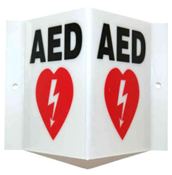Automated external defibrillators (AEDs) are safe and effective for treating ventricular fibrillation when used by professional rescuers 15and trained volunteers in community public access defibrillation (PAD) programs.16 The Public Access Defibrillation Trial included 1900 volunteer responders from 993 community units in 24 North American regions. In this study, volunteers trained and equipped to provide early defibrillation in a structured response system increased the number of survivors to hospital discharge after out-of-hospital cardiac arrest in public locations.16 While PAD programs can improve survival for out-of-hospital cardiac arrest caused by ventricular fibrillation, the effectiveness of defibrillation does diminish over time, making the availability of the device and the time it takes to bring it to the side of the patient very important considerations when establishing PAD programs.17
Why AEDs Are Needed
 While EMS providers will bring a defibrillator to the scene of the emergency, they may not always be able to reach the patient quickly enough. The cardiac arrest victim’s chances of survival decrease by 5 to 10% with every passing minute between the beginning of VF and arrival of EMS. In most communities, the time interval between placing the phone call to 911 and arrival of EMS at the side of the 21 victim is 7 minutes or longer. If you do the math, you can easily see why so many victims die. Help simply did not arrive in time.
While EMS providers will bring a defibrillator to the scene of the emergency, they may not always be able to reach the patient quickly enough. The cardiac arrest victim’s chances of survival decrease by 5 to 10% with every passing minute between the beginning of VF and arrival of EMS. In most communities, the time interval between placing the phone call to 911 and arrival of EMS at the side of the 21 victim is 7 minutes or longer. If you do the math, you can easily see why so many victims die. Help simply did not arrive in time.
Because early defibrillation can be lifesaving, modern defibrillators have been designed specifically for use by the public. Anyone can successfully save lives with use of an AED simply by following the voice prompts from the machine. AEDs can be found in many locations in your community including grocery stores, airports, shopping malls, and public buildings. The devices are most useful if they are conspicuously placed in the open, much the same as fire extinguishers.
Its Not Just About the Box
The challenge with public access defibrillation programs lies in ensuring that potential rescuers are aware of AED locations and understand their role in using the devices. Having an action plan is critically important to the successful use of AEDs. That action plan should be tailor-made for the area it serves. For example, security guards at the entrance to a public building should know the location of the closest AED and respond with it when an emergency occurs within the premises. The designated responder at the location should be trained in CPR regularly and be familiar with the basics of the AED at that site. Without designated responders, the victim may not receive necessary aid in time.
A PAD program can be directed by any responsible party. Some programs are overseen by the local EMS Director. In others, the employee health or building security service take the lead. Often there are not enough AEDs in public places to ensure they are available quickly when needed. Optimally, AEDs must be distributed so that the AED can be retrieved and placed on the victim within the first three minutes following collapse. The AED Implementation Guide (available at www.heartrescueproject.com) for business and industry contains many helpful tips including how to estimate the number of AEDs needed, where to place AEDs, how to address legal and training activities and how to promote your program.
Local EMS can pinpoint good locations for AEDs in conjunction with health departments, schools, local governments, churches, and local businesses. Church groups can purchase AEDs for their congregations. Business owners should invest in the devices for their offices and stores. Each of these groups should have a PAD program with designated responders and should report the location of the AEDs to local EMS providers.

